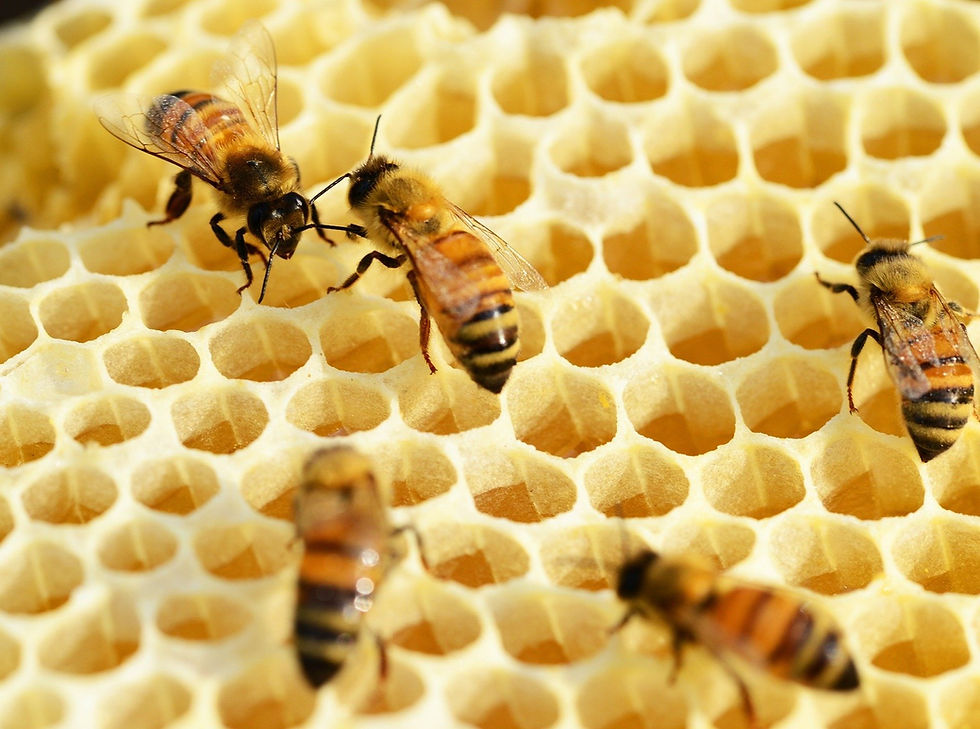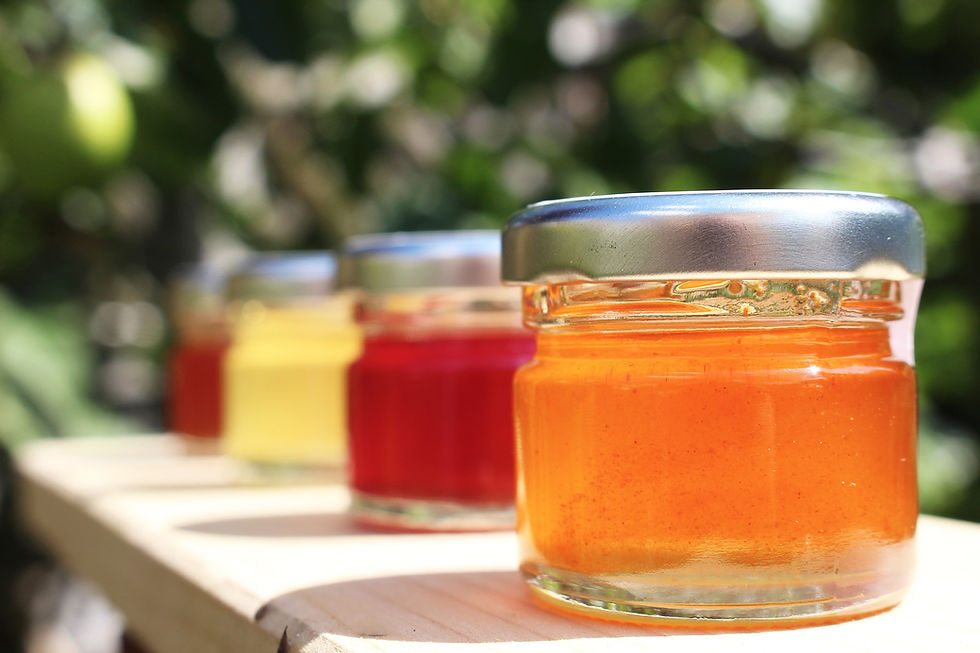HONEY: The golden, sweet pleasure from the beehive
- The Queen Bee

- 8. März 2020
- 4 Min. Lesezeit
Aktualisiert: 1. Sept. 2020
Good quality honey contains over 200 different ingredients. It is produced by the honeybees for their own food provision. This food from the nectar of flowers and the so-called honeydew is adored by many people. There is a wide range of honey. The different flavors are created by pollinating the different types of flowers and flowering shrubs. Honey has fewer calories than sugar. A honey bee travels approximately 8,000 kilometers in its lifetime. Up to 200,000 flight kilometers are required for 1 kilogram of honey

How is honey made?
Honey (Latin and pharmacological Mel) is made from the two raw materials nectar and honeydew. The bees fly from flower to flower and collect nectar and honeydew from the calyx through their long proboscis. For transportation, this raw material is stored in the so-called honey bubble and returned to the beehive.
The bee is capable of high performance. A bee can fly 1 km in 2 minutes. The bee has to fly up to 1.5 million flowers to collect 1 kg of honey. The bee creates up to 30 flowers per minute
Nectar is excreted from flowers. It contains small amounts of amino acids, minerals and vitamins. However, it mainly consists of water and the sugar types sucrose, glucose and fructose.
Honeydew is the excretion product of aphids. These feed on plant sap. The lice excrete the juice because it contains a lot of sugar but only a small amount of amino acids. Sucrose and the multiple sugar melezitose can be found in honeydew, as are small amounts of proteins, amino acids, minerals and vitamins.

The collectors absorb the nectar and honeydew in their honey bubble and fly it back into the bee colony. There they hand over the collected food to a hive bee. This is how food is passed from bee to bee. The honey thickens and is enriched with enzymes and antibacterial acids. The composition changes and the honey becomes more durable.
This happens until the water content is below 40%. Then the honey is stored in the honeycomb by the bees, so to speak as a pantry. Ventilation with the wings lowers the water content and the honey continues to thicken, giving it its typical consistency. The honeycomb is covered and the honey matures with a water content of less than 18%.
Why are there different types of honey?
Je nach Pflanzenart sind die Zuckermoleküle im Nektar oder Honigtau unterschiedlich.
Es können bis zu 500 verschiedene Aromastoffe im Honig enthalten sein, welche vom botanischen Ursprung - also den Pflanzen von denen gesammelt wurde - abhängen.

Depending on the type of plant, the sugar molecules in the nectar or honeydew differ. The honey can contain up to 500 different aroma substances, which depend on the botanical origin - i.e. the plants from which they were collected.
The different varieties are created when the bee flies to a certain traditional plant in a region. Usually these are large fields with plants and flowers. The honey types differ not only in taste, smell and color. The active ingredients are typical of the nectar or honeydew of the plant that produced the raw materials.

Ingredients of honey
From a neutral point of view, honey is a fairly solid, partly jelly-like mass, which partly also consists of whole sugar crystals. Other ingredients are proteins, enzymes, amino acids, minerals, vitamins and trace elements.
Sugar: approx. 80 percent (fructose 27 to 44 percent, glucose 22 to 41 percent, sucrose up to 5 percent, maltose 4 to 14 percent)
Water: about 17 percent
Nutrients and flavorings: approx. 3 percent

Vitamins
Although there are vitamins from the B group and also vitamin C, the concentration plays a rather minor role from a nutritional point of view.
Proteins / Enzymes
The enzymes make it easier for the body to convert the sugar forms and make it easier to use. Proteins are only present in small quantities, but are of great importance due to their support in sugar conversion.
Minerals / Trace elements
Small amounts of calcium, potassium, magnesium, iron, copper, zinc or manganese can be found in honey.
Amino acids / other ingredients
Depending on the origin, the honey contains different concentrations of hydrogen peroxide, flavonoids and pollen. Of particular importance here are the amino acids, which are essential for the metabolism.
Bees can transport more than half of their body weight
How does the beekeeper harvest the honey?

The best time to harvest honey is usually in the second half of July. The beekeeper should wait until there is no more brood and the honey store is well filled. The honeycombs are then removed from the beehive and discovered.
This means that the beekeeper removes the top wax layer of the honeycombs with a comb-like object so that the honey is exposed. Then the honeycomb is placed in a honey extractor and the beekeeper can conveniently fill the fresh honey into glasses.

The remaining wax is usually melted down and used for candles or new honeycombs. The frames are cleaned and prepared so that they can be returned to the beehive.
Types of honey
Here you will find a list of different types of honey:
Flower honey
acacia honey / robinia honey
rapeseed
dandelion honey
tyhmian honey
heather honey
clover honey
phaceli honey
fennel honey
lavender honey
sunflower honey
sweet chestnut honey
Forest honey / honeydew honey
fir honey
spruce honey
oak honey
buckwheat honey
linden honey
Other types of honey
eucalyptus honey
orange blossom honey
thyme honey
jellybush honey

Note
Due to the German Medicines Advertising Act, we are not allowed to make any statements about possible or proven curative effects in the case of diseases. There have been numerous studies and traditions worldwide for many centuries. Thousands of scientists from different countries have now studied the compositions, properties, applications, contraindications and dosage instructions of bee products. We want to give you something to think about through our blogs about natural products, especially bee products. We assume that if we have piqued your interest, you will also use other sources of information (e.g. internet, book trade, trade magazines, ...) to gain extensive knowledge of natural and bee products. Please note that taking bee products does not replace a doctor's visit if you have health problems. Bee products can be used in addition to medication.






Kommentare